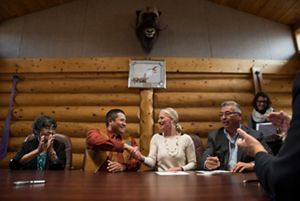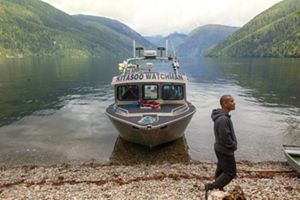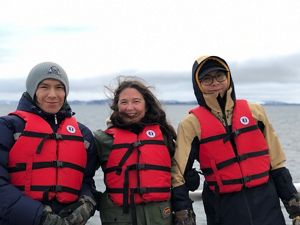The Abundance of the Land
For the Łutsël K’é Dene First Nation, a community hunt and culture camp in Thaidene Nëné is an opportunity to harvest and share knowledge on the land
Story by Jess Dunkin, Photos by Pat Kane
In a small blue cabin on the western shore of Ɂedacho Tué (Artillery Lake), Northwest Territories, a group of women from the Łutsël K’é Dene First Nation are busy processing the hindquarter of a recently harvested hazú ts’ı̨ ɂehjëre (muskox). It’s mid-March and twenty community members, including four students from the Łutsël K’é Dene School, and a handful of guests have travelled to Ɂedacho Tué (Artillery Lake) by snowmobile and ski-plane for a spring hunt and culture camp.
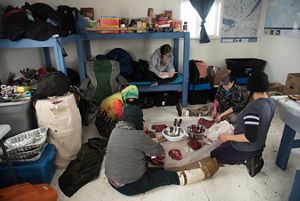
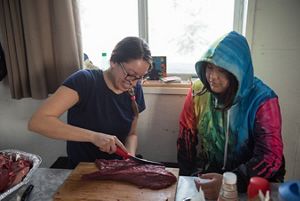
It’s 12-year-old Naomi Michel’s first time making drymeat. “Where do I start?” she asks Elder Terri Enzoe, a knife in hand. “Everyone’s got their own way of making drymeat,” the older woman tells Naomi as she demonstrates her technique. Returning the knife and meat, Terri looks on, offering quiet direction as Naomi uses the blade to thin the deep red flesh.
By lunchtime, strips of hazú ts’ı̨ ɂehjëre (muskox) have replaced frosted goggles and iced-up neck warmers on the racks over the woodstove. If carefully tended—drymeat needs to be turned periodically—the meat will darken and turn to leather, perfectly preserved for travel on the land and life in town.
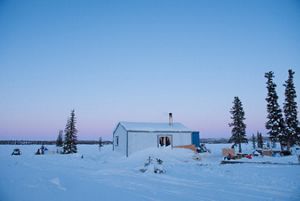
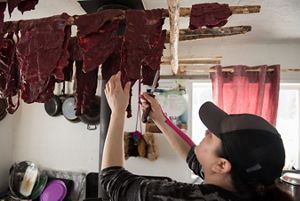
The Guardians of Thaidene Nëné
Ɂedacho Tué (Artillery Lake), which marks the boundary between boreal forest and hazú (tundra), is part of the Thaidene Nëné Indigenous Protected Area, designated by Łutsël K’é in 2019 using their own Dene Laws. Through agreements with Parks Canada and the Government of the Northwest Territories, portions of Thaidene Nëné were also designated a national park reserve, territorial protected area, and territorial wildlife conservation area.
The lake has two important ɂetthën (caribou) crossings, one at the north end, the other not far from the campsite. But as Ni Hat’ni Dene, the Indigenous guardians of Thaidene Nëné, and community members have observed, ɂetthën (caribou) rarely come this way now, just as they no longer come to Łutsël K’é, a community of almost 400 people on the East Arm of Tu Nedhé (Great Slave Lake).
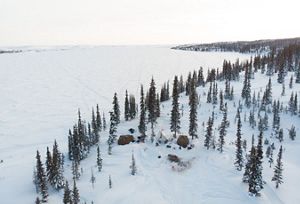
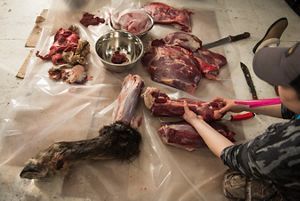
Changing migration patterns and declining numbers prompted Łutsël K’é Dene First Nation to develop "Yúnethé Xá Ɂetthën Hádı," a community conservation and stewardship plan for ɂetthën (caribou). As the plan notes, the Łutsël K’é Dene “rely on ɂetthën (caribou) for physical, cultural, linguistic, emotional, and spiritual sustenance,” and have since time immemorial.
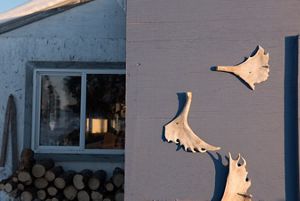
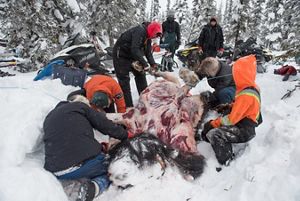
Critical Knowledge Sharing
Caribou Stewardship Plan
The purpose of Yúnethé Xá Ɂetthën Hádı is to protect ɂetthën (caribou) in order to ensure ɂetthën and the Dene way of life continue to exist "as long as the sun shines, the grass grows, and the river flows." Learn more about the plan on landoftheancestors.ca.
Camps like this one are critical for teaching young people how to treat all animals with respect, but they are infrequent because of the cost. The creation of a $30 million trust fund—which Nature United supported by securing $15 million dollars that was matched by the federal government—underwrites Łutsël K’é’s responsibilities within the protected area and enables the delivery of land-based learning opportunities like this one.
In addition to encouraging respectful harvest of ɂetthën (caribou), the stewardship plan urges hunters to seek out other animals, like hazú ts’ı̨ ɂehjëre (muskox), which are more numerous and more accessible than they once were.

"Now they are all around"
“When I was a kid,” Iris Catholique, Łutsël K’é Dene First Nation’s manager for Thaidene Nëné, recalls, “we were allowed one muskox per family per year. We had to come up [to Artillery Lake] at Easter to get that animal. Now they are all around Łutsël K’é.”
The group that travelled to the camp by snow mobile—which included Ni Hat’ni Dene and Ni Hadi Xá, the traditional knowledge monitors for Gacho Kué mine—noticed hazú ts’ı̨ ɂehjëre (muskox) tracks as they arrived to Ɂedacho Tué (Artillery Lake). Two days later, they re-traced their steps, eventually coming across a herd of 15 animals. The animal that opened this story was one of three bulls harvested that day.
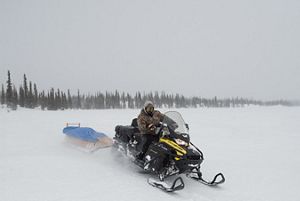
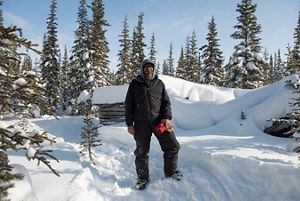
A Hankering for Tundra Trout
While fresh hazú ts’ı̨ ɂehjëre (muskox) is appreciated, Elder and Camp Coordinator JC Catholique is hankering for tundra trout, so mid-way through the week a net is set off Ɂedacho Chela (Artillery Point). With more than a metre of ice on the lake and a thick layer of snow on top of that—the abundance of snow this year is just one of the changes in the land noted by elders and guardians—setting the net is slow going. The harvest over two days is small, but the retrieval of a 30-pound trout puts a smile on the fishers’ faces. JC and his daughter, Saniz, fix the fish, smoking the larger trout for Łutsël K’é elders and cooking what remains on the fire for those in camp.
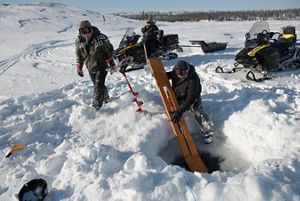
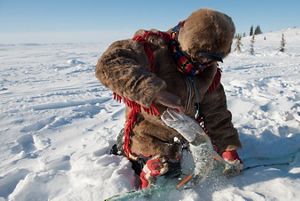
The Abundance of the Land
Toward the end of the week, the group travels north to an old campsite, where at least seven Łutsël K’é Dene families built cabins in the last century to escape an influenza epidemic ravaging communities around Tu Nedhé. In the midst of a global pandemic, the village is a particularly poignant testament to the resilience of the Łutsël K’é Dene.
A fire ceremony closes out the camp. Led by JC, the ceremony is an opportunity to thank the land and the ancestors for keeping the group safe and for providing. Later that same day, the abundance of the land will be shared with the community as camp members deliver smoked trout, drymeat, and muskox quarters to people in Łutsël K’é unable to travel to harvest, including elders.
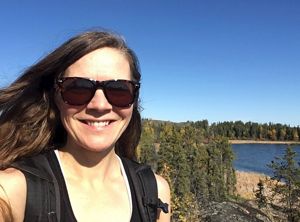
About the Author
Jess Dunkin is a settler writer and historian based in Sǫ̀mba K’è (Yellowknife), Yellowknives Dene territory. The author of Canoe and Canvas (UTP, 2019), Jess’s writing has also appeared in Up Here, Edge YK, and Barista, and on spacing.ca, activehistory.ca, and niche-canada.org. Jess provides communications support to the Łutsël K’é Dene First Nation’s Thaidene Nëné Department.

About the Photographer
Pat is a photographer in Yellowknife, Northwest Territories. He takes a documentary approach to stories about people, life and environment in Northern Canada with a special focus on Indigenous issues, and the relationship between land and identity. View more of his work at patkanephoto.com.
Support Our Work
Nature United has a deep commitment to supporting the leadership and authority of Indigenous peoples across Canada. In places like Thaidene Nëné and the Great Bear Rainforest, we work to advance sustainable economic development while protecting globally significant ecosystems.

